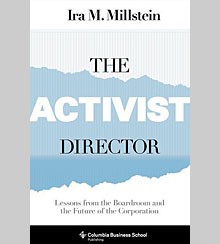The Sisyphean Task of Activating Boards of Directors
Ira M. Millstein, a leading light in corporate governance for decades, makes his case…again.
The Activist Director: Lessons from the Boardroom and the Future of the Corporation
by Ira M. Millstein, Columbia University Press, 2016
Ira M. Millstein opens his new book, The Activist Director (Columbia University Press, 2016), a mashup of memoir and handbook, as if he were standing in front of a jury. “I will build the case for adopting a board-centric approach to corporate governance by placing more activist directors in the boardroom — people who will ask the tough questions, challenge management practices, and resist those who put their own agendas ahead of those of the corporation and investors like you,” writes Millstein, the senior partner at corporate law firm Weil, Gotshal & Manges and adjunct professor at Columbia Law School. “Some will call this pie-in-the-sky idealism. I prefer to call it pragmatic optimism.”
In addition to being an optimist, 90-year-old Millstein is a patient man. He has been making this particular argument for nearly 40 years, since the late 1970s, when he began helping the Business Roundtable draft a series of reports that defined the role and responsibilities of boards. At the time, shareholder activism was starting to manifest itself in leveraged buyouts and hostile takeovers, and Millstein wanted “to ensure that boards exert some initiative to restore corporate competitiveness.”
Toward this end, Millstein didn’t simply write about boards — he advised them. And he advised them to be aggressive. Most notably, he served as external counsel to the board of General Motors for about a decade starting in 1985. During that period, GM was losing money and market share. Yet chairman and CEO Roger Smith, the “Roger” in Michael Moore’s scathing documentary Roger and Me, refused to treat the board as anything more than a rubber stamp — which was the de rigueur role of most corporate boards. Braving Smith’s legendary temper, Millstein helped GM’s board find its feet. And when Smith retired, he advised the board as it took a more active role in governance — hiring Robert Stempel as CEO and then, within two years, firing him and other members of GM’s senior management team when they did not move quickly enough to right the ship.
The managerial coup de grâce delivered by GM’s board in 1992 was a turning point in corporate governance and Millstein’s career. “The General Motors shakeup had a domino effect on corporate America,” Millstein writes. “Not only did GM legitimize the concept of an active board, but soon over a dozen high-profile U.S. boards retained me to advise on board practices, including management oversight.”
Millstein counseled the board of Westinghouse when it fired CEO Paul Lego for mishandling a meltdown in its credit unit. He also helped Planned Parenthood’s board restructure the nonprofit from a loose federation of affiliates to a more coherent, centrally-led structure.
Along the way, Millstein tried to codify and disseminate the lessons he was learning. In 1994, California’s giant and influential pension fund CalPERS adopted the 28 corporate governance guidelines that Millstein helped GM’s board develop — a Magna Carta for directors — as a way to publicly grade governance at the companies in which it made investments. At the invitation of the Organization for Economic Cooperation and Development, he also chaired the Business Sector Advisory Group on Corporate Governance, which developed international governance standards.
It would be nice to report that the verdict on Millstein’s efforts has been rendered and that corporate governance has been transformed. But the case is far from won. “Today,” Millstein reports, “the mantra most common in corporate America is still this: ‘Boards don’t manage, they just oversee.’ Far too many directors take that hands-off approach; they check the legal compliance boxes and otherwise limit their involvement. The future of the corporation — strategy — is left to management. This mantra must change.”
It would be nice to report that Millstein’s efforts successfully transformed corporate governance, but the case is far from won.
And so, like Sisyphus, Millstein again pushes his stone uphill. He remains convinced that boards are the key to responsible, sustainable businesses — and nonprofits and governments, too. In the book’s final chapter, Millstein lays out his manifesto, which is centered on boards taking on the responsibility for staffing themselves, and then finding and appointing directors who demonstrate activist traits.
Activist directors, Millstein tells us, challenge outsized compensation schemes and stand up to pressure from managers, shareholder, and proxy advisors. They are willing to ask tough questions and partner with management in formulating strategy. More fundamentally, they actually care about the companies they serve, and devote significant amounts of time and effort to their posts — for which they should be compensated in kind.
“The world around boards is different today,” Millstein concludes. “The future of our corporations depends on boards recognizing and adapting to this new landscape.” Will Millstein finally win the case he has been making so eloquently for so long this time around? The stone he’s pushing is a heavy one.
Author profile:
- Theodore Kinni is a contributing editor at strategy+business. He also blogs at Reading, Writing re: Management.


